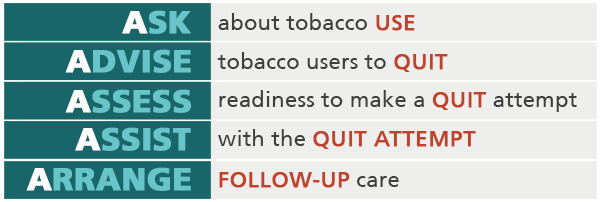|
Decades of research tell us that clinicians can have an important impact on their patients’ likelihood of achieving cessation. Patients who receive a tobacco cessation intervention are up to 2.2 times as likely to quit (at 5 or more months postcessation) compared with patients who did not receive such an intervention. Self-help materials were only slightly better than no clinician. Similarly, the number of clinicians that assist with quitting is related to success rates. Patients who receive a tobacco cessation intervention from two or more clinicians are more than twice as likely to quit (for 5 or more months) than were patients who receive no assistance from a clinician. This provides support for a collaborative team approach to tobacco treatment. The National Cancer Institute’s 5-As model for treating tobacco dependence is:
Each of these is a key component of comprehensive tobacco cessation counseling interventions.
|
|||
|
|
|||
